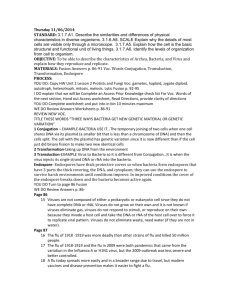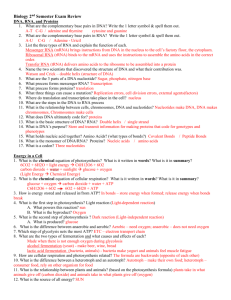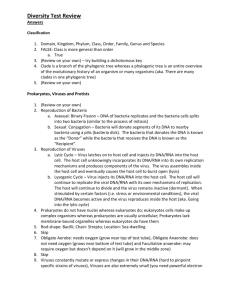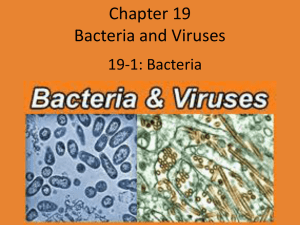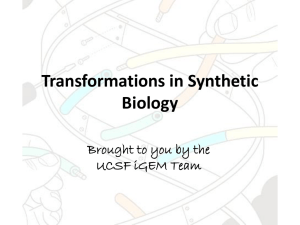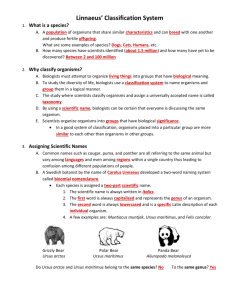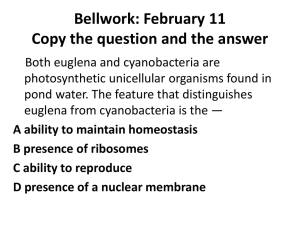Microbe Diversity
advertisement
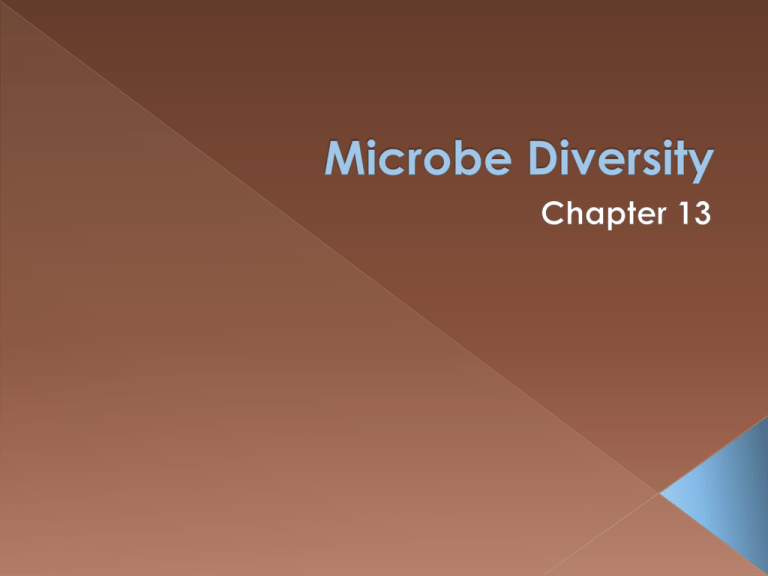
Bacteria (prokaryotes – no nucleus) Archaea (prokaryotes, but with similarities to next group) Eukarya (eukaryotes – have DNA in a nucleus) › Protista – single celled eukaryotes Many different ways of feeding and living Some are plant-like, some animal-like, and some fungal-like › Metazoans – multi-cellular eukaryotes Not cellular › DNA or RNA genetic material › Inside a protein coat Can’t reproduce on own Parasitic on cellular organisms Infects host cell by attaching to outer surface › Injects genetic material Virus DNA/RNA takes over host cell’s metabolism to make its own components New virus parts made, DNA/RNA replicated Parts put together and then the host cell is lysed open Note: host immune system has trouble finding the virus while it’s inside the host cell. RNA viruses › No error checking when replicating › Mutate quickly and so vaccines must be updated regularly › Common cold › Influenze can cause worldwide epidemics DNA viruses › Have error checking enzymes when replicate, so more stable › Small pox – vaccine can give long term protection Chicken pox › One of 8 Herpes viruses to infect humans › DNA virus › Can lie dormant in nerve cells for entire life › Shingles = virus reemerged later in life Transductional Virotherapy uses viruses that recognize cell membrane receptors specific to cancer cells. › Virus attacks and multiplies in cancer cells only Transcriptional Virotherapy uses viruses that can use cancer specific DNA transcription promotor regions › Virus can enter all host cells, but can only use the protein synthesis mechanisms of the cancer cell Prokaryotes › No nucleus › Free ribosomes › No organelles Circular DNA + small circles called plasmids › Plasmids have been used to introduce foreign genes into bacteria Unique forms of inheritance that only bacteria have. Used to make yogurt, cheese, wine, beer & vinegar. E. coli live in your large intestine and help breakdown food Also live elsewhere on body & help defend body from other species that might cause disease. Important decomposers Used to make medicines Pathogenic bacteria Cholera Plague Tuberculosis Tetanus – actually waste product causes symptoms › Syphilis › › › › Just harmful › Acne › Strep throat › Plaque on teeth Share characteristics of bacteria › › › › Size and shape Prokaryote Circular DNA No RNA processing Share characteristics of Eukarya › Histones associate with DNA › DNA replication and repair process › Other metabolic pathways Some characteristics uniquely Archaea › Cell wall has unique molecular structure › Cell membrane has unique components › Some metabolic pathways unique Up to 122 º C (252 º F) around thermal vents Cold temperatures of polar oceans Salt ponds at salinities of 20-25% Sulfuric acid at pH 0 Alkaline environments High pressure of ocean floor (200 atm) Hard to rear in lab Enzymes used in PCR for DNA research Can be used to breakdown oil and materials toxic to other organisms Feed on minerals and can be used to eliminate mineral build up in power plant cooling systems. Aerobic Respiration Anaerobic Respiration Some bacteria use oxygen to generate cell energy. Cyanobacteria were the first organisms to add oxygen to the atmosphere by photosynthesis. Still important oxygen producers today Use alternative energy pathways and can’t function in the presence of oxygen. Tend to be found in sludge at the bottom of lakes or in other places that lack oxygen. A) There would be no more pathogens on earth. B) Human populations would thrive in the absence of disease. C) There would be little change in earth’s ecosystems. D) The recycling of nutrients would be greatly reduced. E) The number of organisms on earth would decrease by 10–20%. A) DNA B) ribosomes C) cytoplasm D) RNA E) mitochondria A) Viruses cannot replicate their own nucleic acids; bacteria can. B) Viral genomes can be replicated faster than bacterial genomes. C) Viruses can replicate their own nucleic acids; bacteria can’t. D) Viruses replicate using transduction; bacteria replicate using conjugation. E) Viral genomes are RNA; bacteria genomes are DNA. First Eukaryotes › Have a nuclear membrane Double layer with pores Regulates the molecules that interact with DNA Probably formed as an in pocketing of the cell membrane › Acritarch fossils 1.9 billion years old = first eukaryotes Cell organelles › Some formed from invaginations of cell membrane › Some by endosymbiosis › Performed specialized functions Larger size Cell respiration enables these cells to produce more energy › Can be more active Move by cilia or flagella Feed on other organisms › Phagocytosis › Endocytosis Digested in food vacuole Elimination by exocytosis Photoautotrophs › Feed themselves by capturing sun energy to make sugar molecules › = Photosynthesis Euglena can also hunt prey when little light is available Some are colonial Some multicellular forms are included = seaweed Reproduce by spores Heterotrophic, but digest outside of body Tend to be sedentary and move by adding cells to colony › Slime molds can form a creeping slug Trypanosoma – sleeping sickness Transmitted by insect Vaccine difficult because proteins of cell membrane change with every cell division Leads to lethargy, coma and death A) Cyanobacteria B) Chemolithotrophs C) Chemoorganotrophs D) Retroviruses E) Plants A) global warming. B) ecological research. C) forestry. D) waste clean up. E) agriculture. A) prokaryotic. B) multicellular. C) eukaryotic. D) marine. E) photosynthetic. A) Plants B) Fungi C) Archaea D) Animals E) Bacteria Cell membrane + Cell wall with outer capsule layer Pili on outer surface have various functions such as attaching to solid surface or moving across that surface

